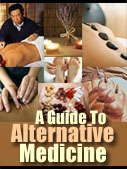Rolfing
Rolfing
The definition of Rolfing is to use physical pressure to stretch
and guide the connective tissue in the body to allow for a better, more flexible movement in
the body.
Moving and breathing techniques are taught to the patient in order
to help facilitate the process.
The myofascial system of the body supports all soft tissues,
defines how the bones are positioned and spaced, and basically is the cause of the shape of
one's body.
When the patient has been realigned properly, they report less
depression and anxiety and have more energy.
They have also reported less pain and better
coordination.
Patients who seek Rolfing as an alternative medicine usually do so
as a result of stress or injury (neck pain) from physically demanding jobs or jobs where they
must be in one position for long periods of time, such as at a computer.
Sports injuries are also cause for seeking relief through
Rolfing.
Students of a balanced life use Rolfing as well. People who seek a
balance and harmony in their physical and emotional life consider Rolfing along with yoga to
be the ultimate in good health keeping.
Professional Rolfists treat all age groups from infants to the
elderly.
Ida P. Rolf (1896-1979) is the founder of the 10 stage treatment
model.
She was an American biochemist and a PhD who discovered the
connective tissue that connects the muscles to the bones could be strengthened and
manipulated.
She believed that the body could become pulled out of its intended
shape by gravity, and muscle and connective tissue reshaping was necessary for good health
and balance.
Unlike the connective tissue massage therapy, she developed 10
sessions geared toward deeper layers of the body, the patient learns to posture better, and
control the invisible line that grounds and connects them to the earth.
The Rolfing sessions are structured so that manual manipulation of
connective tissue along with lessons in relating to gravity will cause the patient to become
more balanced-both physically and spiritually-to the point of the now healthy body beginning
to be able to heal itself.
As connective tissue tends to become dehydrated, shortened or
twisted (as in sports injuries) as a result of the everyday stress and strain of living, it
is unable to perform its job of allowing the muscles to move fluidly, causing all kinds of
havoc in the body.
Rolfing treats the tightness and inflexibility of the connective
tissue in the muscles so that the body can begin to live fully.
As with CST therapy, patients often have emotional outlets during
sessions including crying, resurfaced memories, and have reported feelings of becoming
childlike again.
The 10 Rolfing sessions consist of evaluating the patient's
structure through photos and questions, positioning and repositioning the limbs of the body
and using pressure to indicate where the problems areas are located.
Then the patient is taught breathing techniques which will help
facilitate healing, and in the first seven Rolfing sessions pain and strain are released from
the body.
These Rolfing sessions typically last one to two hours and are
spaced approximately two weeks apart.
Rolfing is so popular that most patients choose to continue the
process after the initial 10 Rolfing sessions as a preventative measure and holistic approach
to well being.
It is important to note that at first Rolfing can be painful or at
least uncomfortable, a lot like deep tissue massage.
The muscles must be released and if they have atrophied from lack
of movement (the old joke about a patient telling the doctor "It hurts when I do this" and
the doctor replying "Well then, don't do that" is so true with muscular stiffness.
When it hurts to move a certain way, we often stop the movement,
causing our muscles to stiffen) and this can be painful at first.
If you have a strong dislike for being touched or have cancer or
arthritis, Rolfing may not be the best course of treatment for you.
|























